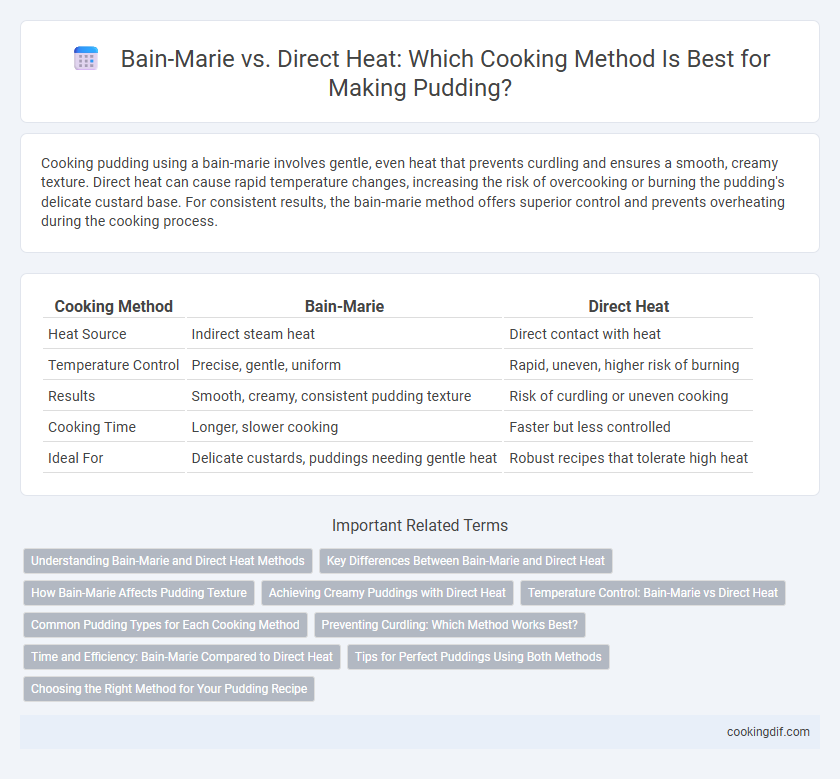Cooking pudding using a bain-marie involves gentle, even heat that prevents curdling and ensures a smooth, creamy texture. Direct heat can cause rapid temperature changes, increasing the risk of overcooking or burning the pudding's delicate custard base. For consistent results, the bain-marie method offers superior control and prevents overheating during the cooking process.
Table of Comparison
| Cooking Method | Bain-Marie | Direct Heat |
|---|---|---|
| Heat Source | Indirect steam heat | Direct contact with heat |
| Temperature Control | Precise, gentle, uniform | Rapid, uneven, higher risk of burning |
| Results | Smooth, creamy, consistent pudding texture | Risk of curdling or uneven cooking |
| Cooking Time | Longer, slower cooking | Faster but less controlled |
| Ideal For | Delicate custards, puddings needing gentle heat | Robust recipes that tolerate high heat |
Understanding Bain-Marie and Direct Heat Methods
The bain-marie cooking method involves gently heating pudding by placing the container in a water bath, ensuring even heat distribution and preventing curdling or scorching. Direct heat applies heat straight to the pudding mixture, which can lead to uneven cooking and increased risk of burning or overcooking. Understanding these methods helps achieve a smooth, creamy texture by controlling temperature and heat exposure during the cooking process.
Key Differences Between Bain-Marie and Direct Heat
Bain-marie cooking involves placing a container of pudding mixture in a water bath to provide gentle, uniform heat, preventing curdling and ensuring smooth texture. Direct heat applies heat straight to the pudding, increasing the risk of uneven cooking and burnt edges due to high temperatures. The bain-marie method offers precise temperature control ideal for delicate puddings, while direct heat speeds up cooking but requires careful monitoring to avoid overcooking.
How Bain-Marie Affects Pudding Texture
Cooking pudding using a bain-marie ensures gentle, even heat distribution, which prevents curdling and results in a smooth, creamy texture. In contrast, direct heat can cause uneven cooking and may lead to a grainy or rubbery consistency. The bain-marie method maintains stable temperatures, allowing delicate proteins in the pudding to coagulate gradually for optimal silky firmness.
Achieving Creamy Puddings with Direct Heat
Using direct heat for cooking pudding requires constant stirring and precise temperature control to prevent scorching and ensure a smooth, creamy texture. Unlike the gentle and even heat distribution of a bain-marie, direct heat can quickly thicken custards and puddings when carefully managed. Mastering low to medium heat settings and frequent agitation allows direct heat methods to achieve rich, velvety puddings without the extended cooking times of water bath techniques.
Temperature Control: Bain-Marie vs Direct Heat
Bain-marie cooking provides precise temperature control by surrounding the pudding mixture with gentle, even heat, typically maintaining water temperature around 85-95degC, preventing curdling or overheating. In contrast, direct heat exposes the pudding to higher, uneven temperatures that can easily exceed desired limits, increasing the risk of burning or uneven cooking. This controlled temperature environment of a bain-marie ensures smooth, creamy pudding texture and consistent results every time.
Common Pudding Types for Each Cooking Method
Common puddings cooked using a Bain-marie include delicate custards like creme caramel and traditional British spotted dick, which require gentle, even heat to prevent curdling. Direct heat is typically used for denser puddings such as chocolate or bread puddings, where faster, more intense heat promotes proper setting and browning. Selecting the appropriate cooking method ensures ideal texture and flavor development for each pudding type.
Preventing Curdling: Which Method Works Best?
Using a bain-marie for cooking pudding helps maintain gentle and even heat, significantly reducing the risk of curdling by preventing the milk or custard from overheating. Direct heat exposes the pudding mixture to high temperatures that can cause proteins to coagulate too quickly, leading to curdling and a grainy texture. For smooth and creamy pudding, the bain-marie method is preferred for its precise temperature control and consistent cooking environment.
Time and Efficiency: Bain-Marie Compared to Direct Heat
Using a bain-marie for pudding cooking ensures gentle, consistent heat distribution that prevents burning and curdling, optimizing texture without constant monitoring. Direct heat applies rapid, uneven high temperatures that can cause scorching and require frequent stirring, increasing cooking time and risk of uneven doneness. Bain-marie's method enhances efficiency by providing stable temperature control, reducing waste and maintaining quality in delicate pudding preparations.
Tips for Perfect Puddings Using Both Methods
Use a bain-marie for gentle, even heat distribution to prevent curdling and achieve a smooth, creamy pudding texture. When cooking over direct heat, stir constantly and regulate temperature carefully to avoid scorching or lumps. For best results, choose the bain-marie method for custard-based puddings and direct heat for thicker, stovetop varieties.
Choosing the Right Method for Your Pudding Recipe
Using a bain-marie ensures gentle, even heat ideal for delicate puddings like custards, preventing curdling and promoting a smooth texture. Direct heat cooks faster but risks uneven cooking and burning, making it suitable only for sturdier, thicker pudding recipes. Selecting between bain-marie and direct heat depends on the pudding's ingredients and desired consistency for optimal results.
Bain-marie vs direct heat for cooking method Infographic

 cookingdif.com
cookingdif.com